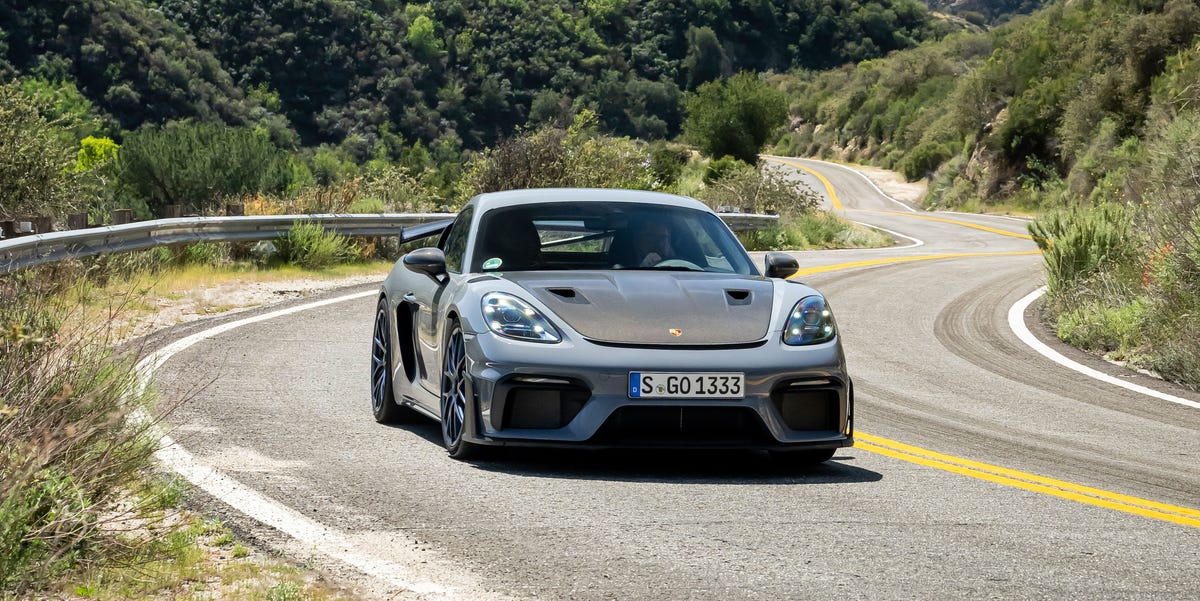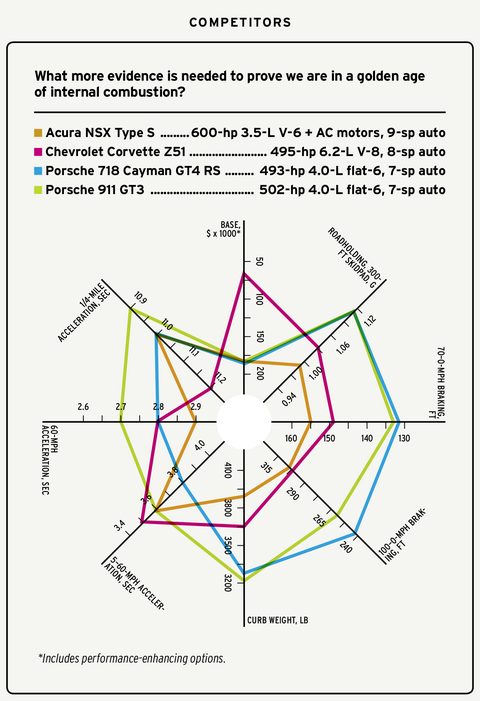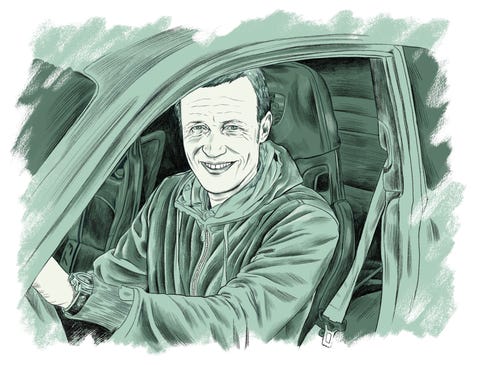Tested: 2022 Porsche 718 Cayman GT4 RS vs. California Highway 39

From the May 2022 issue of Car and Driver.
The San Gabriel Mountains are still growing. As the Pacific and North American tectonic plates crush and grind against one another, the mountains that border Los Angeles continue to creep upwards faster than gravity can pull them down. This creates major headaches for engineers who would dare attempt to build a road through ever-changing terrain. In the case of California’s Highway 39, the result is a spectacular mountain road that goes nowhere, which turns out to be a perfect place to test another engineering marvel, the Porsche 718 Cayman GT4 RS.
Built in the late 1950s, the northern reaches of Highway 39 appear to be intact on most maps, apparently connecting the town of Azusa with the famed Angeles Crest Highway at a summit T-junction. But that hasn’t truly been the case since 1978, when a massive mud and rock slide inundated a section of road at Snow Spring. The road now ends at a locked gate adjacent to a spectacular overlook 6.2 miles shy of the Crest.
Porsche’s Arctic Grey is shockingly close to Highway 39 tarmac, but don’t expect it to work as camo—cops can hear the GT4 RS from a few corners away.
James LipmanCar and Driver
Heading north out of Azusa, 39 wanders past one final housing tract, then bends over a bridge until it slices through a gap in the rock that feels like Turn One, the point where the canyon walls soar, the road gets truly sinuous, and the fun begins as we downshift into attack mode. Almost immediately the shrill note of the GT4 RS’s mid-mounted 4.0-liter flat-six reverberates off the canyon walls as we pass the first of many “Falling Rock” signs and, quite regularly, small crumbs of former mountain that must be accounted for as we sight our line through the onrushing corners.
HIGHS: Mid-mounted GT3 engine, insane grip and braking, howling flat-six note.
Priced from $144,050, if you’re lucky enough to secure one, the GT4 RS undercuts the 911 GT3 by nearly $20,000. Sure, you can nudge it close to $200,000 if you get frisky with the options sheet, but that’s par for the course in Porscheland. What you get for your dollars is a Cayman with the heart and soul of a 911 GT3.
James LipmanCar and Driver
The RS’s six isn’t a massaged version of the enlarged and deturboed 911 engine that powers the 4.0-liter Cayman GT4. This car earns its RS stripes thanks to Porsche fitting the same 911 GT3 Cup–derived engine that powers the vaunted 911 GT3, but spinning it 180 degrees and mounting it beneath the rear parcel shelf, a placement that is less offensive to the laws of physics than the 911’s rear-engine arrangement. In the GT4 RS, this high-revving, naturally aspirated, dry-sump flat-six makes 493 horsepower at 8400 rpm and 331 pound-feet of torque at 6750 revs. It’s worth noting that the same six puts out 502 ponies and 346 pound-feet in the GT3. That makes us wonder whether the difference is truly the result of an exhaust packaging limitation related to the mid-engine placement or a case of preserving Porsche’s sports-car caste system, which puts the 911 GT3 above the GT4 RS.
The GT4 RS makes quick and satisfying work of this early stretch, owing to hyperaccurate steering that gives the arm buckets of information as the fat Michelin Pilot Sport Cup 2 R tires alternately bite left and right into the tarmac. Compared with the GT4, the front and rear track widths of the GT4 RS are broader by 0.2 and 0.3 inch, respectively. The asphalt isn’t consistently smooth, though, so it’s best to leave the two-stage adaptive dampers in the default setting. Struts at all four corners are nothing exotic, but the suspension gives you all the control you need, thanks to track-optimized spring and damper tuning and ball-joint attachment points. It’s a bit punishing around town, but the trade-off is nanometer precision in the canyon.
LOWS: Rough daily ride, PDK only, consider earplugs.
Corners come at a relentless cadence as we skirt past two dams and their attendant lakes. None of the turns are yet tight enough to fully exercise the $8000 carbon-ceramic brakes, which, in conjunction with those Michelins, bring the GT4 RS to a halt from 70 mph in a very short 132 feet, a stop that puts you into the belts with an average of 1.25 g’s of force. It’s great to have such strong brakes to fall back on, but there isn’t all that much slowing to do when Cup 2 R tires Velcro themselves to the tarmac to the tune of 1.11 lateral g’s. If you do work the 16.1-inch front and 15.4-inch rear rotors, the seven-speed dual-clutch automatic snaps off incredibly timed downshifts, putting you in the right gear for every corner.
The front fenders’ trailing edge is cut out to smooth airflow, resulting in improved aero and brake cooling.
James LipmanCar and Driver
A side road called East Fork appears. After a 90-degree turn over a box-girder bridge, this optional diversion runs six miles up a side canyon to another dead end. We won’t be getting out of the GT4 RS to do the 10-mile round-trip hike to the Bridge to Nowhere, an unintended monument to a failed 1930s attempt at roadbuilding that raging floodwaters and bounding boulders abruptly terminated. Instead, we’ll tear ass back to Highway 39.
Some of the last slowpokes you’re likely to encounter will almost certainly peel off at the off-road area and the West Fork trailhead, which is perfectly timed because 39 begins to straighten out north of the Forks. The first long straight comes into view, although it’s not nearly enough road to verify the GT4 RS’s 196-mph top-speed claim. But you can avail yourself of the flat-six’s 9000-rpm wail, which is especially potent because the mid-mounted engine is pretty much a passenger in the cabin, sitting where a back seat would be. Its glorious soundtrack is accentuated by the gulping harmony created by high-mounted air intakes where rear quarter-windows reside in other Caymans, with ducting running right behind your skull to an intake plenum just over your right shoulder. And then there’s the gearing, which is much more closely spaced than the Cayman GT4’s PDK, the effect of which is magnified by an ultrashort RS-exclusive 4.17:1 final-drive ratio.
A four-point titanium roll bar is Europe-spec only.
James LipmanCar and Driver
VERDICT: The no-compromise Cayman we’ve all been waiting for.
Use launch control and the GT4 RS hooks up hard. The time it takes a car to get to 30 mph is a good test of available traction, and the RS’s 1.1-second time is tied for the quickest we’ve measured in a rear-drive car. Acceleration doesn’t let up—60 mph passes in 2.8 seconds. Hold on for 20.8 seconds and 160 mph arrives.
High-speed sweepers collapse into tight, climbing switchbacks. The RS shortens straights into nonexistence as we repeatedly tap its 2.1-second 30-to-50-mph acceleration. Understeer never reveals itself. The holding ability and slightly hunched-forward posture of the one-piece fixed carbon buckets make complete sense as the road climbs ever higher because you’re positioned up on the wheel in a way that gives you steering leverage you didn’t know you would need.
The exposed carbon-fiber hood is part of the Weissach package, which you have to select if you want the 21 pounds of weight savings that comes with the forged magnesium wheels.
James LipmanCar and Driver
Closer to the top, the corners open back up into gentler curves. This is where onlookers in the turnout at the top really start to wonder what the hell is screaming up at them. We rocket past, and the closed gate eventually appears. The assembled motorcyclists and sport-compact enthusiasts try to look unimpressed as we climb out. The GT4 RS’s exhaust pings as it cools, and we notice the odd pebble and small stone bouncing onto the pavement from the cliff above as gravity feuds with the upthrust of the San Gabriel Mountains.
On-again off-again plans to reestablish the connection to Angeles Crest Highway have been on the books since the road closed, with the latest attempt set to have construction start in 2027. Instead of waiting around, we’re turning around and ripping back toward Azusa as fast as we can.

At the Wheel

Illustration by Dilek BaykaraCar and Driver
Andreas Preuninger, director of the GT model line, started with the GT group in 2000 and is responsible for developing the Porsches of Porsches. Under his watch, the GT group has produced a greatest-hits catalog of multiple GT3 generations, the GT3 RS and GT2 RS, and the Cayman GT4. We had a few questions for him, including one about his Ram pickup.
C/D: What is at the core of the cars built by Porsche’s GT group?
Preuninger: A GT car should be one that “talks” to the driver, making [them] an integral part of the performance system and offering a maximum of usable feedback, and should be a feast for all senses at the same time. After getting out of a GT car, the driver must feel that urge to turn around and look at it again while walking away. So it must be the best-looking car within its range, with an unmistakable Porsche GT look that is highly functional as well as beautiful. Lightweight construction and purity are an important part of the GT recipe, too, since you notice weight whenever the car is moving, even at slow speeds. Handling must be confidence-inspiring with an easy controllability even beyond the limit. Being a motorsport product, it has to have the pole-position attitude and a lead regarding lap times even against higher-powered offerings from the competition. And it should sound right.
Has there been any resistance to Caymans that outperform 911s?
Not at all. We make the most of each project and are not afraid to push the limits, even if it means encroaching on cars we have developed. We always want the next car to be the best one. We don’t consider the GT4 RS to be a competitor with non-GT 911s. It’s too different in look and feel and is built for a different purpose.
Will your group ever do an SUV?
I use a Cayenne GTS as my daily driver and am mightily impressed by the performance of the Turbo GT. But GT cars being developed by Porsche Motorsport always have their roots in racing or have a racing sibling, like GT3 Cup or GT4 Clubsport, so there would need to be a Cayenne racing somewhere for us to have a baseline to go from. Never say never, but right now our engineering capacity and racing activities do not enable us to pursue such a step.
Will electrification be brought into the GT group?
Well, time will tell. At the moment, we are pretty busy with the next exciting GT products in the pipeline.
How important is the role of the manual within the GT group?
With cars like the 981 GT4 or the 911 R, we saw the interest for a manual. So since then, we aim to offer the choice to cater to both track rats and enthusiasts who want to savor the experience of a manual, and we hope to do so as long as regulations allow and there is interest from customers.
Has owning a Ram pickup made you look at sports cars differently?
No, not really. I would say it’s reaffirmed my belief that a car doesn’t necessarily need to be perfect in every way, but it should be exciting, entertaining, engaging, and put a smile on your face. There’s more than one way to achieve that, and I was always a fan of big V-8s and the American way of driving. As different as it may seem from driving a GT car, I will always try to have both kinds of cars in my garage.
This content is created and maintained by a third party, and imported onto this page to help users provide their email addresses. You may be able to find more information about this and similar content at piano.io



